#fossil forager
Explore tagged Tumblr posts
Text
I got some adorable stickers and pins from Fossil Forager!
0 notes
Note
do you have any random fungi facts? i crave knowledge/silly
of course i do :-)
prototaxites : "a genus of terrestrial fossil fungi dating from the middle ordovician until the late devonian periods, approximately 470 to 360 million years ago."
these ancient organisms - the largest land-dwelling organism of its time - were recently verified to be fungi !!
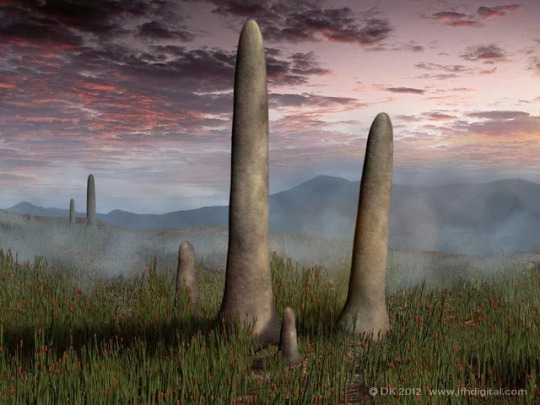

they grew up to 1 metre (3ft) wide & 8 metres (26ft) in height.
#thanks for the ask !! i really love these types of prompts :-)#||#• askbox replies: •#(ask : anonymous user)#[prototaxites]#|#fungi#fungus#mushrooms#nature#earth#cottagecore#mushroom#mycology#forestcore#foraging#biology#science#fossils
190 notes
·
View notes
Text

I saw some Ginkgo at a floor and decor parking lot a couple minutes away from a Home Depot at Union, New Jersey . Looks like it has fruits. I might come back to this spot later to collect .
1 note
·
View note
Text
Working With Hekate
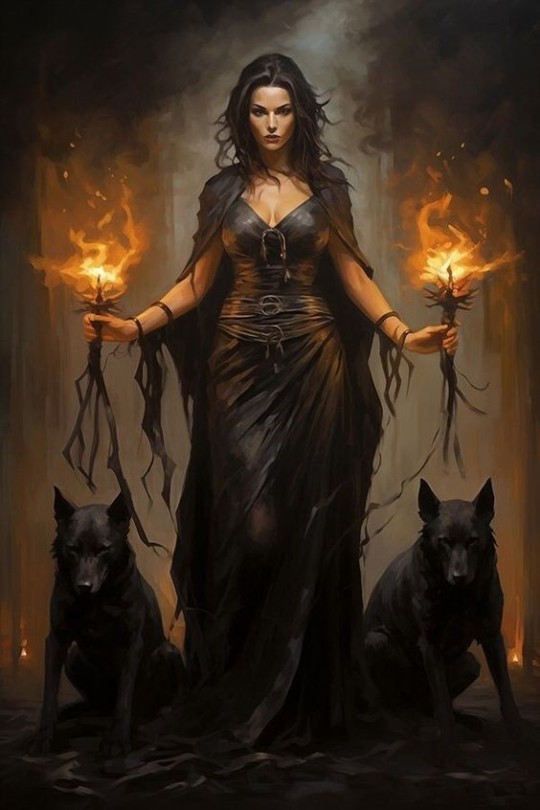
Goddess Of The Threshold
Other titles: Keeper of the Gates, The Triple Goddess, Bringer of Light, Night Wanderer, and many more
Colors: Black, silver, gold, red, white
Herbs: Asphodel, trillium, ebony, fly agaric, garlic, aconite, yew, datura, cypress, belladonna, saffron, foxglove, mandrake, willow, black poplar, dandelion, mugwort, henbane, mandrake, yarrow, myyrh, lavender, oak, mullien, thornapple, bittersweet, poppy, wormwood, sage, rue, fumitory, dragon's blood, rowan, black copal
Crystals: Moonstone (especially black), labradorite, mother of pearl, black tourmaline, obsidian, black/smokey quartz, lodestone, nuummite, serpentine, auralite, abalone, corundum, zicron, hematite, jet, lapis lazuli, pyrite
Element: Earth/water/darkness
Planet: The Moon, Saturn, Pluto
Zodiac: Scorpio (Aquarius)
Metal: Silver, copper, bronze
Tarot: The Moon, The High Priestess
Direction: All
Date: November 16th, the Night of Hekate
Day: Any
Animals: Goats, wolves, dogs, owls, snakes, horses, crows, bulls, sheep, skunks, lizards, dragons
Domains: Thresholds/liminal spaces/boundaries, crossroads, witchcraft and sorcery, the Moon, herbalism, the poison path, necromancy, nocturnal magick, truth, secrets, hedge-riding, shadow work and integration of shadow-self, baneful magick, protection, knot magick, foraging, divination, creatures of the night, the Underworld, the Otherworld
Offerings: Keys, hair of a black dog, any of her sacred plants, representations of any of her animals, divination tools, black mirrors, wands, athames, bolines, blades, things in sets of 3, fruit, wine, blood, rituals/magick in her honor/name, feathers, fossils, shells, bones
Symbols: Blades, fire, keys, crossroads, gateways, doors, entrances, moons, torches, wands/sceptres, whips, the number 3







#satanic witch#magick#witch#lefthandpath#dark#satanism#demons#demonolatry#witchcraft#hekate#hecate#crossroads#threshold#eclectic#eclectic witch#eclectic pagan#pagan community#witches#witch community#witchblr#spirit work#dark goddess#greek goddess#goddess#deities
747 notes
·
View notes
Text

Coming right around the Chinese New Year, top to bottom, are two highly scientifically-important dinosaurs hailing from the Aptian-aged (125-118 mya) Jiufotang Formation of China’s Liaoning Province:
Microraptor zhaoianus ranks alongside the late Jurassic Archaeopteryx and the closely-related Sinornithosaurus as one of the first theropod dinosaurs ever to have discovered with full feather and wing impressions. It measured about 80 cm (2.6ft) in length, had a wingspan of 99 cm (3.25 ft) and weighed about 1.25-1.88 kg, sported a uniquely black but iridescent plumage, and is the namesake of the Microraptoridae, a family of raven-sized dromaeosaurs that dominated the Jehol Biota of the Jiufotang and Yixian Formations and are particularly famous for sporting long flight feathers on both their legs and limbs. This “four-winged” configuration, which surprisingly resembles the hypothetical “Tetrapteryx” stage of bird evolution proposed by naturalist William Beebe in 1915, enabled Microraptor and its kin to glide from tree to tree in pursuit of small birds, lizards and mammals as well as achieving some sort of powered flight over short distances.
Psittacosaurus is a basal ceratopsian that is closer in phylogeny to creatures like Styracosaurus and Triceratops than to the more primitive Yinlong from the late Jurassic, and is one of the most well-preserved and best-studied genera of all non-avian dinosaurs. It reached the size of a pig or a retriever dog and lived throughout much of continental Eastern Asia 125-105 million years ago, and is known for having the most species described of any non-avian dinosaur, with 12 different species ranging from as far north as Siberia to as far south as Thailand. Two of these species were both found in the Jiufotang Formation - P.melieyingensis and P.mongoliensis, the type species which measured up to 2 meters (6.2 ft) long and weighed about 80 kg (44 lb). Psittacosaurus had highly-developed senses of smell and vision, a pair of protruding jugal (cheek) bones that were possibly used for display, and was active for short periods at day or night. Psittacosaurus also possessed self-sharpening teeth that were used for cropping and slicing tough plants, and unlike future ceratopsians, it lacked teeth for chewing and grinding food and thus used gastroliths (which would have been stored in a gizzard similar to those of modern birds) to wear down the leaves and bark that it ate as it passed through the digestive system. Psittacosaurus is also unique among ceratopsians for having a large, well-proportioned brain. This indicates that the dinosaur was capable of doing a wide range of complex social behaviors such as bird-like sleeping, nest-building and parental care. This is perhaps true with possible instances of overburdened Psittacosaurus parents brining in a nanny or another guardian to take care of large nests of more than a dozen hatchlings, as evidenced of fossils of adolescent females preserved with several hatchlings together. The Psittacosaurus of the Jiufotang Formation shared their temperate forest habitat with the basal ankylosaur Chuanqilong, several genera and species of paravians and pterosaurs, a large titanosaur, and the 10-meter-long Yutyrannus relative Sinotyrannus, and Psittacosaur hatchlings and occasionally adults were also preyed upon by the large, badger-like mammal Repenomamus. One fossil Psittacosaurus specimen that is on display at a German museum (SMF R 4970) preserves the scales, colors and integument that the living animal would have had, and they indicate that the particular Psittacosaurus had a counter-shaded reddish brown and beige pattern that was blurrier and less-defined compared to the striking orange-and-white colors of Sinosauropteryx (which was suited for a lifestyle of foraging in open areas) and was therefore useful for camouflaging the Psittacosaurus in the woods. The specimen also possessed a strange crest of yellow, keratinized, bristle-like structures protruding from the base of its tail that were quite similar to the thin, filamentous structures found on the heterodontosaurid Tianyulong, which also possibly indicates that feather-like structures or proto-feathers may have appeared early in the evolutionary history of the dinosaurs and were soon lost in the evolution of some dinosaur groups or retained in some form in the evolution of others.
#microraptor#psittacosaurus#paleoart#dinosaur#dinosaurs#paleontology#paleontology art#paleoblr#paleoartists on tumblr#dromaeosaurid#ceratopsians#ceratopsian#dromaeosaur#dinosaur art#dinosaur artwork#cretaceous#early cretaceous#aptian#albian#dinoblr#palaeontology#palaeoart#paleontography
319 notes
·
View notes
Text
There is a growing body of physiological, anatomical, ethnographic, and archaeological evidence to suggest that not only did women hunt in our evolutionary past, but they may well have been better suited for such an endurance-dependent activity. We are both biological anthropologists. I (co-author Cara) specialize in the physiology of humans who live in extreme conditions, using my research to reconstruct how our ancestors may have adapted to different climates. And I (co-author Sarah) study Neanderthal and early modern human health. I also excavate at their archaeological sites. It’s not uncommon for scientists like us—who attempt to include the contributions of all individuals, regardless of sex and gender, in reconstructions of our evolutionary past—to be accused of rewriting the past to fulfill a politically correct, woke agenda. The actual evidence speaks for itself, though: Gendered labor roles did not exist in the Paleolithic era, which lasted from 3.3 million years ago until 12,000 years ago. The story is written in human bodies, now and in the past.
[...]
Our Neanderthal cousins, a group of humans who lived across Western and Central Eurasia approximately 250,000 to 40,000 years ago, formed small, highly nomadic bands. Fossil evidence shows females and males experienced the same bony traumas across their bodies—a signature of a hard life hunting deer, aurochs, and woolly mammoths. Tooth wear that results from using the front teeth as a third hand, likely in tasks like tanning hides, is equally evident across females and males. This nongendered picture should not be surprising when you imagine small-group living. Everyone needs to contribute to the tasks necessary for group survival—chiefly, producing food and shelter, and raising children. Individual mothers are not solely responsible for their children; in forager communities, the whole group contributes to child care. You might imagine this unified labor strategy then changed in early modern humans, but archaeological and anatomical evidence shows it did not. Upper Paleolithic modern humans leaving Africa and entering Europe and Asia show very few sexed differences in trauma and repetitive motion wear. One difference is more evidence of “thrower’s elbow” in males than females, though some females shared these pathologies. And this was also the time when people were innovating with hunting technologies like atlatls (spear throwers), fishing hooks and nets, and bow and arrows—alleviating some of the wear and tear hunting would take on their bodies. A recent archaeological experiment found that using atlatls decreased sex differences in the speed of spears thrown by contemporary men and women. Even in death, there are no sexed differences in how Neanderthals or modern humans buried their dead or the goods affiliated with their graves. These indicators of differential gendered social status do not arrive until agriculture, with its stratified economic system and monopolizable resources. All this evidence suggests Paleolithic women and men did not occupy differing roles or social realms.
1K notes
·
View notes
Text
Fossil Crocs of 2024
Another year another list of new fossil crocodilians that greatly expand our knowledge of Pseudosuchia across deep time. Happy to say that this is my third time doing this now, so I'm not going to bog you down with the details and get right into it.
Benggwigwishingasuchus
Our first entry, sorted by geological age of course, is Benggwigwishingasuchus eremicarminis (desert song fishing crocodile) from the Middle Triassic (Anisian) of Nevada. It was a member of the clade Poposauroidea, which some of you might recognize as also containing such bizarre early croc cousins like Arizonasaurus and Effigia. Also notable about Benggwigwishingasuchus is that it was found in the Fossil Hill Member of the Favret Formation. Why is that notable? Well the Fossil Hill Member preserves an environment deposited 10 km off the Triassic coastline and also yielded fossils of animals like Cymbospondylus, the giant ichthyosaur. Despite this however, Benggwigwishingasuchus shows no obvious signs of having been a swimmer or diver. Instead, its been hypothesized that it was simply foraging around the coast and might have been washed out to sea.
Artwork by Joschua Knüppe (@knuppitalism-with-ue) and Jorge A. Gonzalez
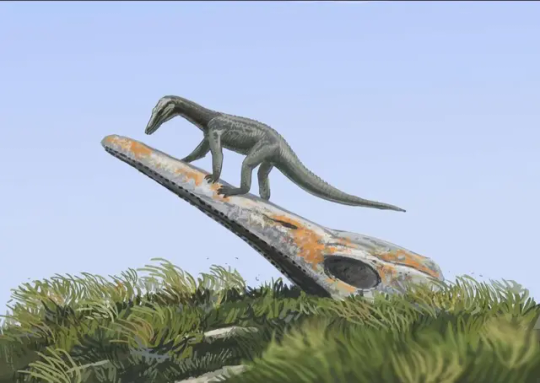
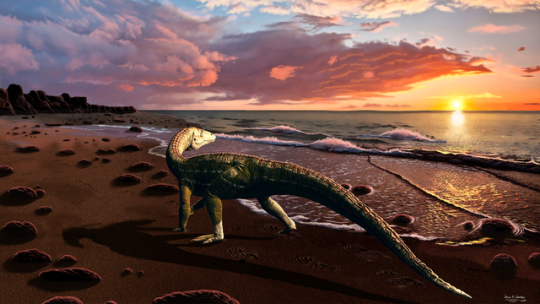
Parvosuchus
Fast forward some 5 million years to the Ladinian - Carnian of Brazil, specifically the Santa Maria Formation. Here you'll find the one new genus on the list I did not write the wikipedia page for: Parvosuchus aurelioi (Aurélio's Small Crocodile). With only a meter in length, Parvosuchus is amongst the smallest pseudosuchians of the year and a member of the aptly named Gracilisuchidae. Santa Maria was actually home to multiple pseudosuchians, including the mighty Prestosuchus (and its possible juvenile form Decuriasuchus), the small erpetosuchid Archeopelta and larger Pagosvenator and one more...
Artwork by Matheus Fernandes and Joschua Knüppe
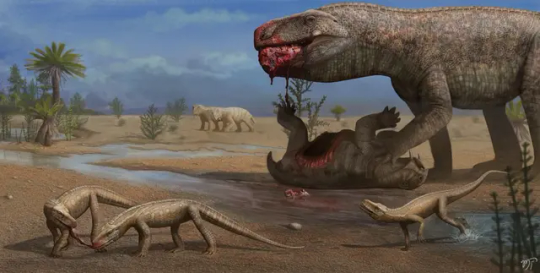

Schultzsuchus
Yup, Santa Maria has been eating good this year. Before the description of Parvosuchus, scientists coined the name Schultzsuchus loricatus (Schultz's Crocodile). Now this one's not entirely new and has long been known under the name Prestosuchus loricatus (by which I mean since 1938). What's interesting is that this new redescription suggests that rather than being a Loricatan, Schultzsuchus was actually an early member of Poposauroidea like Benggwigwishingasuchus. Even if it was no longer thought to be close to Prestosuchus, it was liekly still a formidable predator and among the larger pseudosuchians of the formation.
Artwork by Felipe Alves Elias

Garzapelta
Our last Triassic pseudosuchian and our only aetosaur of the year came to us in the form of Garzapelta muelleri (Mueller's Garza County Shield). It comes from the Late Triassic (Norian) Cooper Canyon Formation of, you guessed it, Garza County, Texas. As an aetosaur, the osteoderms are already regarded as diagnostic, tho unlike some other recent examples there is a little more material to go off from. It's still primarily osteoderms, but at least a good amount and even some ribs.
Artwork by Márcio L. Castro

Ophiussasuchus
Our only Jurassic newcommer is Ophiussasuchus paimogonectes (Paimogo Beach Swimmer Portuguese Crocodile), but arguably you couldn't find a better posterchild for Jurassic crocodyliforms. This new lad is a goniopholidid from the Kimmeridgian to Tithonian Lourinhã Formation, yup, Europe's Morrison. It's anatomy is perhaps not the most exciting, like other goniopholidids it had a flattened, very crocodilian-esque snout and was likely semi-aquatic like its relatives.
Artwork by @manusuchus and Joschua Knüppe


Enalioetes
Another quintessential group of Jurassic crocodyliforms are the metriorhynchoids, however, 2024's only new addition to this clade was actually Cretaceous, specifically from the earliest Cretaceous (Valanginian) of Germany. Like Schultzsuchus, Enalioetes schroederi (Schroeder's Sea Dweller) is new in name only, as fossil material has been found at the latest in 1918 and given the name Enaliosuchus "schroederi" in 1936. This kickstarted a whole series of taxonomic back and forth until the recent redescriptoin finally just gave it a new name and settled things (for now). Looking back I realize that I really need to take the time and fix up the Wikipedia page. Tho I've written its current status, I was kinda limited by being on vacation and never dived into the description section.
Artwork by Joschua Knüppe and Jackosaurus
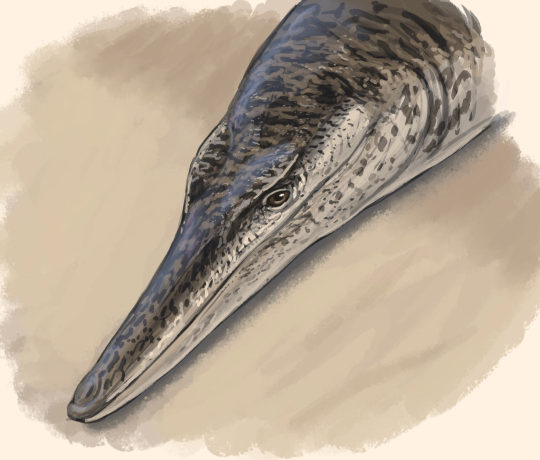

Varanosuchus
Another Early Cretaceous crocodyliform is Varanosuchus sakonnakhonensis (Monitor Lizard Crocodile from the Sakon Nakhon Province), described from Thailand's Sao Khua Formation. It lived around the same time as Enalioetes, but otherwise couldn't have been more different. Where Enalioetes was fully marine, Varanosuchus was more a land dweller as evidenced by the deep skull and long, slender legs. At the same time, some other features, like its more robust limbs compared to its kin, might suggest that Varanosuchus could have still spent some time in the water like some modern lizards. Tho one might be reminded of Parvosuchus from earlier, Varanosuchus is a much more recent example of small terrestrial croc-relatives, the atoposaurids, which are much closer to todays crocodiles and alligators.
Artwork once again by Manusuchus

Araripesuchus manzanensis
Yet another example of a small, gracile land "crocodile" comes to us in the form of Araripesuchus manzanensis (Araripe Basin Crocodile from the El Manzano Farm). And once again, it belonged to a completely different group, this time the notosuchian family Uruguaysuchidae. Now Araripesuchus is well known as a genus, in part due to the work of Paul Sereno and Hans Larsson (who popularized the names "dog croc" and "rat croc" for two species). Tangent aside, A. manzanensis is known from the upper layers of Argentina's Candeleros Formation, corresponding to the Cenomanian (earliest Late Cretaceous). The same locality also yielded A. buitreraensis, from which A. manzanensis can be distinguished on account of its blunt molariform teeth in the back of its jaw. This dentition, which corresponds to a durophageous diet of hardshelled prey, could explain how it coexisted with the related A. buitrensis at the same locality, allowing the two to occupy different niches. There is a neat little animation done for this animal you can watch here.
Artwork by Gabriel Diaz Yantén

Caipirasuchus catanduvensis
We're staying in South America but moving to Brazil's Adamantina Formation for our next entry: Caipirasuchus catanduvensis (Caipiras Crocodile from Catanduva). This one is a little more recent, tho the age of the Adamantina Formation is a bit of a mess far as I can tell, ranging anywhere from the Turonian to the Maastrichtian. One could also argue that C. catanduvensis is part of the "lanky small croc club" that Parvosuchus, Varanosuchus and A. manzanensis belong to, but I feel that the very short snout helps it stand out from that bunch more easily. Anyhow, Caipirasuchus catanduvensis is a member of Sphagesauridae, related to Armadillosuchus, and herbivorous. What's really interesting tho is that the internal anatomy suggests the presence of resonance chambers not unlike that of hadrosaurs, possibly suggesting that these animals were quite vocal. This could also explain why baurusuchids appear to have had very keen hearing.
Artwork by Joschua Knüppe and Guilherme Gehr
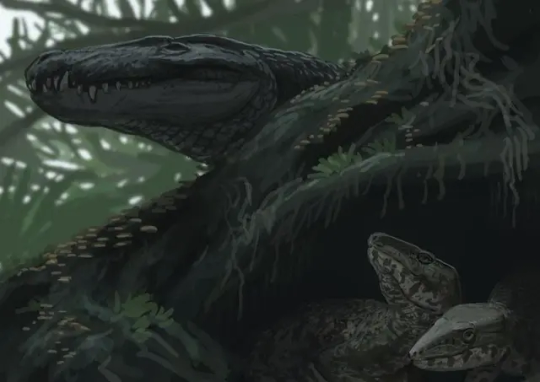

Epoidesuchus
We're staying in the Adamantina Formation for our last Mesozoic croc of the year, Epoidesuchus tavaresae (Tavares' Enchanted Crocodile). Tho also a Notosuchian like Araripesuchus and Caipirasuchus, this one belongs to the family Itasuchidae (or the subfamily Pepesuchinae depending on who you ask), which stand out as being rare examples of semi-aquatic members of this otherwise largely terrestrial group. Epoidesuchus was fairly large for its kin and had long, slender jaws. Like I said, Epoidesuchus and its relatives were likely more semi-aquatic than other notosuchians, something that might explain the relative lack of semi-aquatic neosuchians across Gondwana. They aren't absent mind you, but noticably rarer than they are in the northern hemisphere.
Artwork by Guilherme Gehr

And thus we move into the Cenozoic and towards the end our or little list. From here on out, say goodbye to Notosuchians or other weird crocodylomorphs and get ready for Crocodilia far as the eye can see.
Ahdeskatanka
The first Cenozoic croc we got is Ahdeskatanka russlanddeutsche (Russian-German Alligator), which despite its name comes from North Dakota, specifically the Early Eocene Golden Valley Formation. Ahdeskatanka is similar to many early alligatorines like Allognathosuchus in being small with rounded, globular teeth that suggest that it fed on hardshelled prey. This would have definitely helped avoid competition in the Golden Valley Formation, which also housed a second, similar form not yet named, a large generalist with a V-shaped snout similar to Borealosuchus and the generalized early caiman Chrysochampsa, also large but with a U-shaped snout.
Artwork by meeeeeeee

Asiatosuchus oenotriensis
We had an alligatoroid, so now its time for a crocodyloid. Asiatosuchus has been recognized from the Late Eocene Duero Basin of Spain for a while now, but now we have a name: Asiatosuchus oenotriensis (Asian Crocodile Belonging To The Land Of Wine). Asiatosuchus is a complex genus, most often not really forming a monophyletic clade and likely representing several distinct or at least successive taxa that form the "Asiatosuchus-like complex". Within this complex, A. oenotriensis is thought to have been close-ish to Germany's Asiatosuchus germanicus.
Artwork by Manusuchus

Sutekhsuchus
Rounding out the trio of major crocodilian clades is Sutekhsuchus dowsoni (Set's Crocodile/God of Deception Crocodile), representing our only gavialoid of the year. Originally described as Tomistoma dowsoni in 1920 based on fossil remains from the Miocene of Egypt, Sutekhsuchus has been at times regarded as distinct and at other times lumped into Tomistoma lusitanica. It was one of several early gavialoids to inhabit the coast of the Tethys during the Miocene and appears to have been most closely related to the genus Eogavialis, clading together just outside of the American and Asian gharials. A fun little personal anecdote, I prematurely learned about this one due to a friend highlighting the name in a study on Eogavialis. Never having heard of "Sutekhsuchus" I took to google scholar, where I found a single result: a reference to the then unpublished description, which naturally I ended up eagerly awaiting.
Artwork by Manusuchus and Joschua Knüppe
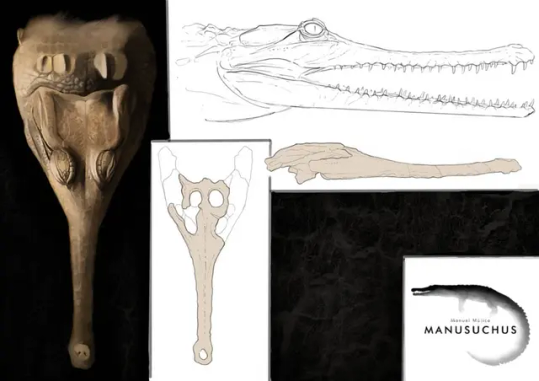
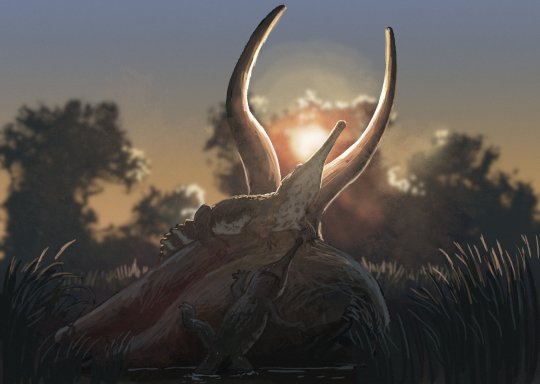
Paranacaiman
Two more and we're done. First, completely arbitrarily, Paranacaiman bravardi (Bravard's Caiman from Parana) from the Miocene Ituzaingo Formation of Argentina. Material of this genus has originally been referred to Caiman lutescens, described in 1912 but now considered a nomen dubium. Paranacaiman is known from limited material only, just the skull table, but that would indicate a "huge" animal. My personal scaling recovered a size of almost 5 meters in length, similar to large black caimans today.
Once again, credit to me

Paranasuchus
Last but not least, Paranasuchus gasparinae (Gasparini's Crocodile from Parana). Coming from the same deposits as Paranacaiman, this one too has been known as a species of Caiman for some time before being assigned its own genus, though it at least got to retain its old species name. Alas, I have not scaled it myself, tho its material is at least more extensive than that of Paranacaiman, including even parts of the snout. A little nitpick because I don't have much to say, but I personally think the name was ill conceived. On its own both Paranacaiman and Paranasuchus are fine names don't get me wrong, but together, coined by the same authors in the same study no less, they strike me as needlessly confusing to non experts. Both are caimans, both are from Parana, so the distinction between "Parana Caiman" and "Parana Crocodile" is entirely arbitrary and doesn't really distinguish them. Not helped by the fact that they are even closely related in the original description. Other than that tho another good addition to our understanding of fossil crocs.
No artwork on this one, but fossil material from Bona et al. 2024

And that wraps up 2024. I hope This post, or my posts throughout the year or even my work on Wikipedia has helped to make these fascinating animals just a little bit more approachable and a massive thanks to all the artists who took their time to create fantastic pieces featuring these incredible animals. Special shout outs to Manusuchus, who diligently illustrated a lot of the featured animals and Joschua Knüppe, who had to listen to me suggest Ahdeskatanka every Sunday for about two months straight now.
Fossil Crocs of 2023
Fossil Crocs of 2022
#paranasuchus#paranacaiman#ahdeskatanka#sutekhsuchus#ophiussasuchus#epoidesuchus#caipirasuchus#araripesuchus#enalioetes#parvosuchus#benggwigwishingasuchus#schultzsuchus#garzapelta#varanosuchus#paleontology#prehistory#palaeoblr#long post#fossil crocs of 2024#paleo#paleonotlogy#crocodilia#crocodylomorpha#pseudosuchia#fossils#2024
260 notes
·
View notes
Text
Round 3 - Mammalia - Pilosa

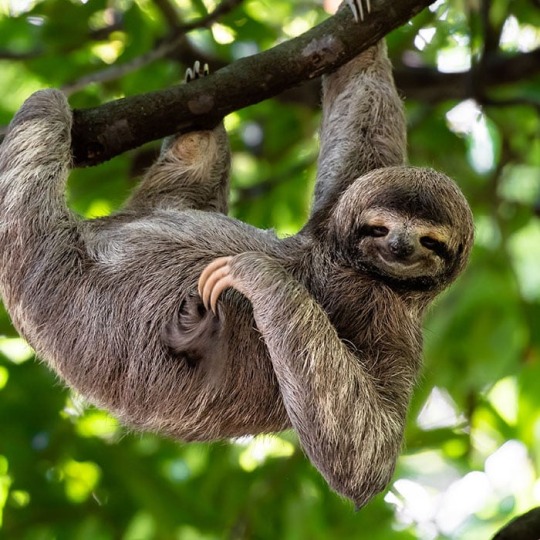
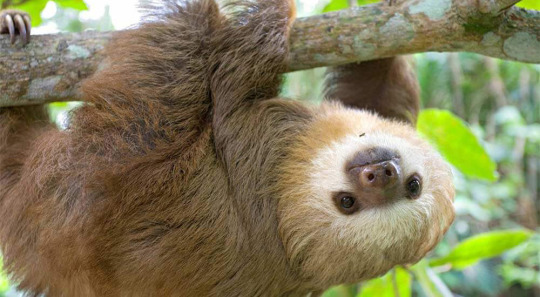

(Sources - 1, 2, 3, 4)
Our next and last order of xenarthrans is Pilosa, the “anteaters” and “sloths”. Pilosa comprises the families Cyclopedidae (“Silky Anteater”), Myrmecophagidae (“Giant Anteater” and “tamanduas”), Bradypodidae (“three-toed sloths”), and Choloepodidae (“two-toed sloths”).
Pilosa is derived from the Latin word for “hairy”, and refers to these animals’ characteristic bushy, wiry fur. Most living pilosans are arboreal or semi-arboreal (the only exception being the Giant Anteater [Myrmecophaga tridactyla]), with long, strong claws for gripping tree branches, defending from predators, and/or digging up insects. Pilosans have thick necks and forelimbs adapted for gripping, climbing, and/or digging. Their eyesight is poor, but they have a good sense of smell which they use to find food.
Anteaters use a long, sticky tongue to lap up termites, ants, and other insects. As they have no teeth, they press their tongues against the roof of their mouth to smash the insects for swallowing. Their stomachs, similar to a bird's gizzard, have hardened folds to crush food, assisted by ingested sand and soil. They cannot produce stomach acid of their own, but digest using their prey’s own formic acid. Giant Anteaters walk on their front knuckles, similar to gorillas and chimpanzees, to protect their long, sharp claws from scraping on the ground, while tamanduas walk on the sides of their clenched forefeet when walking on the ground.
Two-toed sloths are omnivorous, with a diverse diet of insects, carrion, fruits, leaves, and small lizards. Three-toed sloths, on the other hand, are almost entirely herbivorous. Most living sloths mainly eat the leaves of Cecropia trees. They have made many adaptations for arboreal browsing. Leaves, their main food source, provide very little energy or nutrients, and do not digest easily, so sloths have large, slow-acting, multi-chambered stomachs in which symbiotic bacteria break down the tough leaves. Their digestive process can take a month or more to complete. Sloths are adapted for a life spent entirely in the trees. While they sometimes sit on top of branches, they usually eat, sleep, and even give birth hanging from branches. They sometimes remain hanging from branches even after death. Their limbs are adapted for hanging and grasping, not for supporting their weight, and they have very little muscle mass. Sloths descend about once a week to urinate and defecate on the ground. They cannot walk on the ground, but must drag themselves when needed. However, they are capable of swimming quite well, as are other pilosans.
Pilosans are generally solitary, though females tend to tolerate each other’s presence more than males. They come together only for mating, sometimes spending a courtship period of several days together. They give birth to one baby, once or twice a year (sometimes longer for sloths as their slow movement can make it hard to locate mates). Young pilosans are born with a full coat of fur. The young will ride on the back or belly of its parents until weaned, or are left in a nest or on a branch while the mother forages.
The biogeographic origins of Pilosa are still unclear, but they can be traced back in South America as far as the early Paleogene (about 60 million years ago). Anteaters and sloths diverged around 55 MYA, between the Paleocene and Eocene epochs. Both the Giant Anteater and the Southern Tamandua are well represented in the fossil record of the Late Pleistocene and early Holocene.

Propaganda under the cut:
The Silky Anteater’s (Cyclopes didactylus) (image 4) feet are highly modified for climbing. Its hind feet nearly encircle a branch while clinging, while it has a large third claw on each front foot. It also has a semi-prehensile tail to increase its grip on tree branches.
The Silky Anteater usually dwells in Silk Cotton Trees (genus Ceiba), curled up in a ball sleeping during the day. Because of its resemblance to the fluffy seed pod fibers of these trees, it can use the trees as camouflage and avoid attacks of predators such as hawks and Harpy Eagles (Harpia harpyja).
The largest living pilosan is the Giant Anteater (Myrmecophaga tridactyla) (image 1), which is on average 182 to 217 cm (6 to 7 feet) in length, with weights of 27 to 50 kg (60 to 110 lb).
The Giant Anteater is the most terrestrial of the living anteater species. Specialization for life on the ground appears to be a new trait in anteater evolution, an adaptation to the expansion of open savanna habitats in South America, and the abundance of native colonial insects, such as termites, that provided a larger potential food source.
The Giant Anteater has poor eyesight, but a powerful sense of smell: 40 times that of a human.
When Giant Anteaters need to rest, they carve a shallow cavity in the ground. They then sleep with their bushy tail draped over their body like a blanket, both to keep warm and to camouflage from predators. Sometimes, they will sleep splayed out in order to sunbathe.
Male Giant Anteaters are territorial and will challenge each other by approaching and circling each other while uttering a "harrr" noise. This can escalate into chasing and actual fighting. Combat includes wrestling, slashing with the claws, and bellowing.
Giant Anteaters are not typically aggressive, choosing to run from danger. But when they need to fight, they can rear up and use their front claws defensively. The front claws of the Giant Anteater are formidable weapons, capable of potentially killing a jaguar. At least three humans have been killed by defensive Giant Anteaters.
Southern Tamanduas (Tamandua tetradactyla) (see gif above) are used as pest control, specifically for termites and ants, by Indigenous peoples, who sometimes bring the tamanduas into their homes to take care of these insects.
Southern Tamanduas avoid eating ant and beetle species that have strong chemical defenses.
The most famous extinct sloth is the elephant-sized Giant Ground Sloth, Megatherium americanum, but there were a wide diversity of not just smaller ground sloths, but also semi-aquatic sloths like Thalassocnus and large, omnivorous sloths like Mylodon. Today, only the slow-moving, arboreal tree sloths remain, showing that the best way to survive extinction (for a sloth) is to take to the trees, and be as inedible as possible.
The two living groups of tree sloths are from different, distantly related families, and are thought to have evolved their morphology via parallel evolution from separate terrestrial ancestors.
The shaggy coat of sloths has grooved hair that is host to symbiotic green algae which camouflage the animal in the trees and provide it nutrients. The algae also nourish sloth moths, some species of which exist solely on sloths. Sloths benefit from their relationship with moths because the moths are responsible for fertilizing the algae on the sloth.
Sloths are unusual among mammals in not having seven cervical vertebrae. Two-toed sloths have five to seven, while three-toed sloths have eight or nine. (The other mammals not having seven are manatees, with six.)
Sloths can hold their breath underwater for up to 40 minutes. They do this by reducing their already slow metabolism even further and slowing their heart rate to less than a third of normal.
Individual sloths tend to spend the bulk of their time feeding on a single tree. By burying their dung near the trunk of that tree, they also help fertilize it. Their symbiotic moths also lay their eggs in their dung at the base of the tree; the caterpillars eat the dung and then fly up to the sloth as adult moths.
Sloths are victims of animal trafficking where they are sold as exotic pets. However, they make very poor pets, as they have such specialized ecology.
The critically endangered Pygmy Three-toed Sloth (Bradypus pygmaeus) is found exclusively on Isla Escudo de Veraguas.
The Maned Sloth (Bradypus torquatus) is one of the only sloths which show any form of sexual dimorphism, with their mane of black hair being larger and darker in males than in females.
The Pale-throated Sloth (Bradypus tridactylus) is occasionally known as the “Ai”, due to its bird-like whistle described as an "ai-ai" sound.
The Southern Maned Sloth (Bradypus crinitus) is described as having a head that looks like a coconut, with its species name crinitus (meaning “hairy”) even being a reference to its coconut-like head.
Female Brown-throated Sloths (Bradypus variegatus) (image 2) are known to emit a loud, shrill scream during the mating season to attract males. Their cry is reported to sound like that of a woman screaming.
Linnaeus's Two-toed Sloth (Choloepus didactylus) is the largest living sloths species, growing to lengths of approximately 53 to 89 cm (1.9 to 2.9 ft), and weighing approximately 4 to 11 kg (9 to 24 lb).
Hoffmann's Two-toed Sloths (Choloepus hoffmanni) (image 3) have actually been seen walking on their palms and soles, rather than dragging themselves across the ground like other sloths.
Sloths are not entirely defenseless, and can slash a predator with their long claws or bite with their sharp canines if threatened.
149 notes
·
View notes
Text

Lessiniabatis aenigmatica was a rather strange stingray.
It lived around 50-48 million years ago during the early Eocene, in a shallow warm sea covering what is now Italy, with its three known fossil specimens all coming from the fish-rich Monte Bolca fossil beds.
About 60cm long (~2'), it had a round pancake-like body similar to many modern seafloor-dwelling stingrays – but uniquely it was also almost tailless, with only a tiny, slender, stingless tail.
It wasn't a particularly strong swimmer, instead probably spending most of its time buried in the muddy seafloor sediment. When on the move it likely swam along just above the surface of the seafloor using undulations of its fins, foraging for smaller bottom-dwelling animals like worms, molluscs, crustaceans, and fish.
—
NixIllustration.com | Tumblr | Patreon
#science illustration#paleontology#paleoart#palaeoblr#lessiniabatis#dasyatoidea#myliobatiformes#stingray#batoidea#ray#elasmobranch#chondrichthyes#cartilaginous fish#fish#art#sea pancake
532 notes
·
View notes
Text
Dandelion News - January 8-14
Like these weekly compilations? Tip me at $kaybarr1735 or check out my Dandelion Doodles!
1. In Chicago, all city buildings now use 100 percent clean power

“As of January 1, every single one of [Chicago’s municipal buildings] — including 98 fire stations, two international airports, and two of the largest water treatment plants on the planet — is running on renewable energy, thanks largely to Illinois’ newest and largest solar farm.���
2. California Rice Fields Offer Threatened Migratory Waterbirds a Lifeline

“Cranes need nighttime roosting sites flooded to a depth of about 3 to 9 inches, so they can easily hear or feel predators moving through the water. [... Bird Returns pays] farmers to flood their fields during critical migration periods [... and] provide foraging sites by leaving harvested rice or corn fields untilled, so cranes can access the leftover grain.”
3. New York Climate Superfund Becomes Law

“[Funds recovered “from major oil and gas companies” will be used to pay for] the restoration of stormwater drainage and sewage treatment systems, upgrades to transit systems, roads and bridges, the installation of green spaces to mitigate city heat islands and even medical coverage and preventative health programs for illnesses and injuries induced by climate change.”
4. Austin says retooled process for opening overnight cold-weather shelters is paying off

“[... T]he city's moves to lower the temperature threshold to open shelters and announce their activation at least a day in advance were the result of community feedback. [Shelter operators also passed out hot food.]”
5. Helping Communities Find Funding for Nature-Based Solutions

““From coastal oyster reefs to urban stormwater greenways, nature-based solutions are becoming the new normal.” That’s because these types of projects are often less expensive to build and have additional community benefits, such as improving water quality or creating parkland.”
6. Saving the Iberian lynx: How humans rescued this rare feline from extinction

“Back in the early 2000s, fewer than 100 individuals roamed the wild, including only 25 reproductive females. [...] Conservation staff [...] shape these cats into resourceful hunters and get them ready for life outside the center. [...] They’re fine-tuning captive-breeding routines, improving veterinary procedures, and pushing for more wildlife corridors.”
7. Biden cancels student loans for 150,000 more borrowers

“The 150,000 new beneficiaries announced Monday include more than 80,000 borrowers who were cheated or defrauded by their schools, over 60,000 borrowers with total and permanent disabilities and more than 6,000 public service workers[...] bringing the number whose student debt has been canceled during [Biden’s] administration to over 5 million[....]”
8. PosiGen wins another $200M for lower-income rooftop solar

“PosiGen offers a “no credit check” [solar panel installation to] those with a higher percentage of their income going to power and fuel bills[....] “somewhere between 25 and 75 percent” of the consumer’s monthly energy savings could come from efficiency measures such as sealing heating and cooling leaks, replacing thermostats, and installing LED lights[....]”
9. Indigenous communities come together to protect the Colombian Amazon

“At this year’s COP, Indigenous peoples celebrated the [protection of] traditional knowledge, innovations and practices[... and] the Cali Fund, which ensures that communities, including Indigenous peoples, receive benefits from the commercial use of [...] genetic data derived from the biological resources that they have long stewarded.”
10. How the heartland of Poland’s coal industry is ditching fossil fuels - without sacrificing jobs

“[Katowice, a former coal city] committed to reducing CO2 emissions by 40 per cent compared to 1990, prioritising investments in green infrastructure, and promoting renewable energy and energy efficiency. [...”]The gradual departure from heavy industry did not bring high social costs in our city,” says Marcin Krupa, Mayor of Katowice City.”
January 1-7 news here | (all credit for images and written material can be found at the source linked; I don’t claim credit for anything but curating.)
#hopepunk#good news#chicago#clean energy#renewableenergy#california#birds#cranes#migratory birds#climate action#climate crisis#climate change#new york#texas#homelessness#unhoused#homeless shelter#nature#green infrastructure#lynx#iberian lynx#spain#endangered species#student debt#solar energy#indigenous#poland#solar panels#solar power#biodiversity
60 notes
·
View notes
Note
Best games for mental health&relax?
As someone who deals with anxiety and depression when I want to relax or am just feeling low and drained I’ll usually choose what others would consider “cozy games” because I don’t want any stress from shooters, strategy games, or anything that has a lot of stakes. I’ll do switch games for now since it’s my main console but I do have a 3ds, psvita, and my computer so I’ll make a list of those games later 💕
So my favorite games to relax to are:
~ stardew valley~ (you already knew this was coming) it’s just a really cute game with lots of options on how you can spend your time. You can farm, fish, forage, travel the mines, talk to the towns people, interact with love interests. There is just a lot to do in it and it has a really cozy small town cottagecore vibe that a lot of people find relaxing. Amazing replay value. I have like four different lives just so I can choose different farms, partners, things like that.
~ animal crossing~ (second most obvious answer) we all know animal crossing is a chill low stakes game that has a lot of similar elements I listed for stardew valley. You get to interact with cute little animals, decorate your house and character, forage, fish, find fossils, shop. It’s just a relaxing and positive game and is very popular for a reason. Idk about replay value because I really couldn’t imagine deleting my island tbh.
~ fashion dreamer~ if you like cute dress up type games this one is a decent lil game. It’s got lots of different styles for whatever your lil fashion heart desires and you basically walk around dressing up characters and they rate your outfits. It’s from the creators of style savvy and while it’s super cute I would wait for it to go on sale because it’s a bit overpriced imo. Style savvy is definitely the way to go if you have a ds/3ds. Still cute though. Don’t know about replay value because I’m fairly new to the game and haven’t come close to finishing or restarting anything.
~ unpacking~ this one is pretty cute and definitely a game that helps with anxiety. It’s a relaxed little puzzle game that unlocks parts of the story as you go along organizing each room to your home. You can try to solve the puzzles or you can just organize the furniture to your liking. Either way you want to play it’s super cute and relaxing and has some decent replay value after you complete it.
~calico~ super cute game where you run a cat cafe in a magical town with unique characters, little missions, and lots of cats you can pet and play with. There is magic, desserts, and you can ride giant cats like horses. Super soothing game. Character customization and decorating your cafe. The only drawback is it can get a bit glitchy but for the cuteness and the price I have no complaints. The music is really cute too. Not sure about replay value because my cafe is so cute I wouldn’t want to start over.
~coffee talk~ you run a coffee shop in the future and talk to all the incoming guests and learn their stories as you give them their coffee. This one is super relaxing and how I like to spend my evenings before bed if I want that extra cozy time to destress and relax. Cute art as well with different species and how they interact. I haven’t restarted yet but I’m sure there will be replay value with just how cozy and in depth the story is.
~rune factory 4 remastered~ this was originally a 3ds game they remastered for the switch and it’s so amazing that they did. One of my favorite 3ds games that is an offshoot of the harvest moon series with very pretty art, farming, cooking and crafting, romance, monster fighting, and just really fantastic story telling. Very cozy and hard not to get sucked into. Such a gorgeous game imo. Fantastic replay value.
~good pizza, great pizza~ you run a lil pizza shop and upgrade it to get better ingredients and equipment. Super cute chill game to pass the time and hard not to spend hours mindlessly making pizzas. Haven’t replayed it because I haven’t completed it but I imaging replaying it would be fun because you’re just making pizza and unlocking different ingredients. Relaxing game with cute art.
~monster prom~ cute game where you have to convince one of the monsters to go to prom with you. Funny writing, pretty art, and the ability to romance any gender while choosing your pronouns. It’s funny, the game play is question based, and it’s like little rounds of 15 mins and either you get them to go to prom or you get rejected. Then you get to try again. Replay value is obviously strong because I keep playing it no matter how often I’m rejected 🥲 being real though this game is funny, unique, and worth the price. I just have to beat the first one so I can try the second.
~what comes after~ you play as a character on a train of ghosts and you process the grief of passing to the afterlife and try to learn and console the other ghosts on the train who are passing. Pretty game that is mostly story based and worth a try. I haven’t finished this game so I’m not to sure on the replay value.
~little mouse’s encyclopedia~ a cute little game where you play as a little mouse exploring the outside and the dirt and you spend your time finding other little animals and bugs and plants and you read about them and what they are. Cute little educational game I purchased because I loved the art that ended up being super cute in the long run.
Honorable mentions:
- speed dating for ghosts (cute funny little game where you go on dates with ghosts. Short, sweet, and to the point. Decently priced for how quick you get through the game)
- cattails (you play as a cat that travels through its little territory you that you share with your other cat group. You gather little things, complete missions, scrap with rival cat gangs, and just walk around as a cat. Cute but a bit slow for my tastes.)
-rune factory 5 (don’t get me wrong, I love the fourth one and I’m sure the more I play this one I’ll learn to love it to. The gameplay is just set up a bit different and is a bit more similar to the harvest moon style than the fourth rune factory. The art is gorgeous though I was just hoping for more rune factory and less harvest moon when it came to the actual playing)
Games I’ve wanted and heard amazing things about:
The only reason I haven’t purchased and played these games yet is because games aren’t cheap and I need to finish the ones I’ve already purchased. That being said I’ve been looking at a lot of these for a long time and they are definitely going to make this list. I’m sure some of them would be ranked very high in the favorite games category as soon as I actually start playing them. Here’s the list:
* Spiritfairer
*Bear and breakfast
*Creepy tale
*Cozy grove
*Witchy life story
*Potion permit
*Hoa
*Littlewood
*Potion craft
*Gris
*When the past was around
*strange horticulture
*Lemon cake
*Wytchwood
*How to say goodbye
*Dreamlight valley
*Storyteller
*Cult of the lamb
*Little misfortune
*Night in the woods
* Sally face
And that’s it 🎉 sorry for such a long list but I wanted to include a bit of everything so you had lots to choose from. These are the games I play when I need a comfy happy place to go when life gets to be a bit too much to handle. I enjoyed making this list to be honest so there will most likely be more lists in the future. Maybe I’ll make a list of favorite otome games, anime/manga, kpop groups. Things like that. Anyway, hope you enjoy reading the list as I enjoyed making it 💖
#awkwardgamergirl#gamer girl#gaming#stardew valley#animal crossing#cozy grove#fashion dreamer#unpacking#calico#coffee talk#rune factory 4#rune factory 5#monster prom#good pizza great pizza#what comes after#spirit farer#bear and breakfast#creepy tale#witchy life story#potion craft#potion permit#littlewood#little misfortune#strange horticulture#Gris#disney dreamlight valley#cul of the lamb#wytchwood#how to say goodbye#storyteller
249 notes
·
View notes
Text
Please read my dni in my bio before interacting
Since everyone wanted a post like this! Here you go! :3
Computer games to play when regressed!
I'll say the name, price and I'll do a brief description and content warning for each game (if you think I should add a CW for any that I didn't put one for feel free to tell me and I'll add it)! I'll also be making another post like this for phone games! :3
🌸=personal favourites
You can get all of these games off steam!
100 hidden frogs
Description- this is a short game where you look for 100 frogs in an image!
Price- free!
CW- none! :3
🌸Alba a wildlife adventure
Description- in this game you explore and take photos of animal, there is also a main storyline where you restore an animal reserve!
Price- £13.49
CW- wild fire
Baba is you
Description- a puzzle game where you change words around to create new rules to win the levels, the puzzles can be quite tricky!
Price- £11.39
CW- none! :3
🌸Birth
Description- a puzzle game where you collect organs and bones to build a partner for yourself, I recommend this game for if you like spookier games but don't wanna play something too scary!
Price- £8.29
CW- bones and organs (not realistic ones), bugs, brief appearance of m*d!c*l equipment
Calico
Description- a game where you own a cat cafe, explore the world, complete quests and find more animals for your cafe, I recommend only playing this game if you can use a controller because it's difficult to play on keyboard!
Price- £9.29
CW- none! :3
🌸Cat cafe manager
Description- you run a cat cafe and are able to collect new cats, decorate and upgrade the cafe, this game can be a bit tricky since it is a management game!
Price- £16.75
CW- capitalism?
The cat games
Description- a game where you play different cat themed games, I'd recommend this game for if you regress to older ages since it can be a bit tricky!
Price- £1.59
CW- none! :3
Cat goes fishing
Description- you catch fish and upgrade your boat with the money you get from them, it can be a bit tricky to catch the bigger fish!
Price- £4.99
CW- deep water
Catlateral damage 1 and 2
Description- you play as a cat and have to knock things of tables and shelves to earn points, I recommend this game for if you regress to younger ages!
Price- £8.50
CW- bones, one of the levels is a mad scientist lab and has some creepy stuff
Cattails
Description- you play as a cat in a cat colony, there's a main storyline and you can have kittens, make your own colony, fight other cats, forage etc!
Price- £10.99
CW- fighting, hunting of small animals
Cloud gardens
Description- this is a post apocalyptic game where you grow plants and build apocalyptic scenes, it's quite relaxing a good game for any regressors who don't wanna play a stereotypically 'cute' game but still wanna play a relaxing and fairly simple game!
Price- £13.99
CW- post apocalyptic
Cozy grove
Description- a game where you play as a scout and help bears on an island!
Price- £11.39
CW- swearing, dark backstorys? (I haven't finished the game yet so I'm not 100% certain!)
Dorfromantik
Description- in this game you put tiles together to make a landscape, this game is a really relaxing and calm game!
Price- £10.99
CW- none! :3
Flower
Description- you play as the wind collecting flower petals, the game is quite relaxing but can be a lite it tricky!
Price- £5.89
CW- pollution is a key theme in the game
Fossil corner
Description- you make/find fossils! That's it really but it's a relaxing game!
Price- £7.19
CW- none! :3
The game of life 2
Description- it's based off the game of life boardgame! You play through the life of someone! You can play the game with AI or with friends, personally I also like playing it with my stuffies!
Price- £10.49
CW- none! :3
Haunt the house terror town
Description- you play as a little ghost and you have to haunt different locations to make all the people leave!
Price- £4.29
CW- non-graphic death
Koi farm
Description- you make different types of koi fish by breeding them to get different colours and patterns!
Price- £2.09
CW- none! :3
Kynseed
Description- you live in a medieval village and can explore, have a job, family etc, the game can be a lil creepy so I recommend this game more if you regress to older ages!
Price-£19.99
CW- can be a bit creepy
🌸Lil gator game
Description- this games adorable, you play as an alligator who's playing games with their friends! It's a bit tricky to describe the game but you're basically playing a game in a game, it's very cute!
Price- £16.75
CW- none! :3
Littlewood
Description- a game where you rebuild a town! You can get married, explore, decorate houses etc, keep in mind the game is incomplete and has been abandoned!
Price- £11.39
CW- none! :3
Mail time
Description- you play as a mail scout and hace to deliver letters to different characters!
Price- £16.75
CW- none! :3
🌸My fluffy life
Description- there are different little activities to play in the game and they change season to season, you can also buy clothes and furniture for your character! The mini games are quite easy so I recommend this if you regress to younger ages!
Price- £3.99
CW- none! :3
Paradise marsh
Description- a relaxing game where you explore a variety of weather and seasons and overall environments while collecting bugs and talking to the stars!
Price- £12.79
CW- bugs, the game is a bit ominous
Pupperazzi
Description- super cute game where you take pictures of dogs!
Price- £15.49
CW- none! :3
🌸A short hike
Description- really similar vibes to lil gator game (this game came out first) you explore a forest, make friends and climb to reach the top of a mountain!
Price- £5.79
CW- I don't really remember the contents of the phone call but once you reach the top of the mountain you have a phone call and I believe it might be upsetting
🌸Slime rancher 1 and 2
Description- a sandbox game where you collect little slimes and explore the world, you can also disable dangerous slimes to make the game easier!
Price- £14.99/£23.79
CW- none! :3
🌸Stardew valley
Description- you inherit your grandfathers farm and move to a town in stardew valley, you can farm, forage, mine, fish and form relationships with the villagers!
Price- £10.99
CW- substance abuse, mental health, family issues
🌸Sticky business
Description- you own a sticker shop and you make new stickers and ship them to customers!
Price- £8.50
CW- none! :3
Teacup
Description- you help a shy frog find everything she needs to host a tea party for her friends!
Price- £7.19
CW- none! :3
🌸Undertale
Description- you're a child who falls through a mountain where monsters have been trapped, you have to help the child leave the caverns! There are multiple endings depending on if you kill or don't kill any monsters!
Price- £6.99
CW- death of characters (it can be quite sad), most of the more upsetting content is in the route where you kill all the monsters
🌸Wobbledogs
Description- a game where you evolve dogs and look after them
Price- £15.99
CW- they do eventually die but you can turn off their deaths in the settings, the game can be a bit uncomfy and 'strange' so keep that in mind
🌸World of zoo
Description- a game where you look after animals in a zoo!
Price- £11.90
CW- zoo
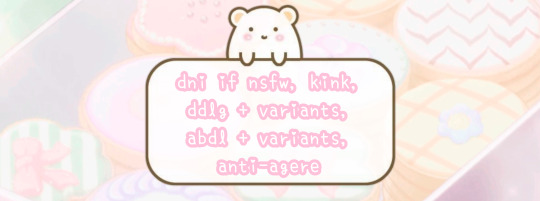
#agere#age dreaming#age regression#age regressor#sfw agere#agere blog#sfw littlespace#sfw smolspace#agere games#agere activities#snailsagere
521 notes
·
View notes
Text
MARAUDERS ERA DR INTRO !!
BASICS ౨ৎ-----------------------------------------------------------------
||*.name: venus mayumi
||*.nicknames: rings, vee
||*.birthday: 06/04 (11)
||*.pronouns: she/her
||*.occupation: student @ hogwarts
||*.ethnicity: filipino/japanese/german
||*.blood status: half-blood
APPEARENCE + MOODBOARD

⋆.˚ lil blurb: i have vitiligo, which affects my eye, skin in some smaller patches, and the front bits of my hair, making them lighter ⋆.˚
SCHOOL/SOCIAL ౨ৎ-----------------------------------------------------
||*.house: gryffindor
||*.friends: marauders & valkyries, + regulus black (♡), dorcas meadows, pandora rosier, kingsley shacklebolt, & emmeline vance (civil w/ the skittles/emeralds bc of reg)
||*.animagus form: raccoon
||*.personality/social life: lowkey a little loud, def more similar to james & sirius than remus & peter, but i actually know when to shut tf up, and i'm generally well-liked. there isn't as much hatred of other houses, and a lot of the death eater/pureblood stuff is way less prevelant, so friendly rivalries are common, but no all-out hatred. me n sirius are beaters for the gryffindor quidditch team (i'm also lowkey ripped asf hehehe), but i end up having to drop out mid fifth year from an injury, so me n lily end up commentating (lmao).
||*.hobbies:
muggle volleyball thrifting, crocheting, embroidery, & sewing singing + playing electric guitar jewlery making rock, fossil, and bone collecting/foraging parkour roller skating quidditch
WORLD STUFF ౨ৎ--------------------------------------------------------
||* uniforms arent as strictly enforced, fridays, weekends, and non-school days like holidays you can wear regular clothes undr your robes, accessories are always allowed (jewelry, belts, hair shit, etc.)
||* there are a bunch of extra curriculars available like different clubs, etc. and theyre lowkey super fun theres like baking club, art club, care of magical creatures, its so sick.
||* they do so many fancy events theres a halloween masquerade ball, easter ball, valentines day dance, autumn/spring equinox events, etc. also the triwizard tournament didn't get banned and there was one in my fourth year bc i said so
||* it's genrally recognized that students within the same house arent all the same sow hile friendly competition is encouraged, it's also common for students to have friends from other houses, and ppl are allowed in other house's dorms & common rooms if they're invited
||* there is a bioluminescent cave pool under the castle and its so fun to hang out in oh my god its not cold or anything its just soso cool
||*voldemorts downfall happens the year after we graduate (aka the order destroys all the horcruxes), and nobody i know well dies so none of the betrayal happens, but regulus does end up taking the mark but dosen't believe in all that shit & works as a spy (snape could NEVER) for the order, and still destroys the horcrux but survives and fully leaves his family (suck it walburga and orion)
MISC/TRIVIA ౨ৎ-----------------------------------------------------------
has three pets, two cats and an owl, whos names are mocha, shinya, & ghost, (the cats r technially communal between me n the valkyries bc they live in the dorms w us, but idc)
bands/music artists and slang r all the same as they are now, but technology etc is all 70s (w/o the homophobia racism etc)
i shift in the day before i get my hogwarts letter
sirius and reg are irish twins so while reg is still younger hes in our year (along w the rest of the skittles/emeralds its for simplicity)
there is a creek/river system in the forest and its so cool to hangout near theres like fossils and bones and cool rocks and shit EVERYWHERE i love it
the lake is swimmable (unless you can't swim cough cough regulus black) and its super fun theres a dock and floating platforms and stuff its amazing when its hot out
the dr follows kind of an atyd type timeline of events w exceptions
౨ৎ---------------------------------------------------------------------------
that's all pretty much!!! thats a long one lmao sorry abt that but also if y'all knw any younger raspier british fem voiceclaims pls tell me im in the trenches rn trying to find a british vc that dosent sound like shes in bridgerton lmao ok byeeee love u
85 notes
·
View notes
Text
Fossil Friday: Paraceratherium

Paraceratherium is an extinct relative of modern-day rhinos. It was initially found in Pakistan but fossils have been found from the Balkans to China. It lived during the Oligocene Epoch 34-23 Ma. It was discovered by Guy Ellcock Pilgram in 1907.

It’s been found in a number of formations including the Chitarwata Formation in Pakistan, the Hsanda Gol Formation in Mongolia,

the Jiaozigou Formation in China,

and the Güngörmez Formation in Turkey.

Each of these formations represents a different habitat that Paraceratherium inhabited. The Chitarwata Formation was a coastal plain with tidal flats along an estuary.

The Hsanda Gol Formation was an arid desert basin with little in the way of trees or bushes.

The Jiaozigou Formation was a semi-arid woodland represented by fluvial conglomeratic sandstones and silty mudstones.

The Güngörmez Formation represents a delta into a swampy lake.

Paraceratherium lived alongside animals such as Didymoconus,

Amphechinus,

a number of rodents and lagomorphs,


Proailurus,

Hyaenodon,

Anthracotherium,

Paraentelodon,

Bugtilemur,

Progiraffa,

and Deinotherium.

Paraceratherium belongs in the class Mammalia, in the order Perissodactyla, in the suborder Ceratomorpha, in the superfamily Rhinocerotoidea, in the family Hyracodontidae, in the clade Paraceratheriidae.

Paraceratherium is the largest land mammal to have ever existed (that we know of). It is estimated to have been 24.3 ft (7.4 m) long, a shoulder height of 17.2 ft (5.25 m) and a weight of 33,000 to 44,000 lbs. (15-20 tonnes).

The skull is 4.3 ft (1.3 m) long and lacked the roughened area of other rhinos where horns would attach. The nasal bones are very long and the incision goes deep into the skull suggesting it had a prehensile upper lip like modern Blacka and Indians do. Maybe it even had a little trunk! It has attachments for strong neck muscles to allow it to sweep its head while foraging.

Unlike those of most primitive rhinocerotoids, the front teeth of Paraceratherium were reduced to a single pair of incisors in either jaw, which were large and conical, and have been described as tusks. The upper incisors pointed downwards; the lower ones were shorter and pointed forwards. The canines were lost and the incisors were separated from the cheek teeth by a diastema (gap).

The atlas and axis vertebrae of the neck were wider than in most modern rhinoceroses, with space for strong ligaments and muscles that would be needed to hold up the large head. The rest of the vertebrae were also very wide, and had large zygapophyses with much room for muscles, tendons, ligaments, and nerves, to support the head, neck, and spine. The neural spines were long and formed a long "hump" along the back, where neck muscles and nuchal ligaments for holding up the skull were attached.

The limbs were large and robust to support the animal's large weight, similar to elephants and sauropods. Unlike such animals, which tend to lengthen the upper limb bones while shortening, fusing and compressing the lower limb, hand, and foot bones, Paraceratherium had short upper limb bones and long hand and foot bones.

Due to its enormous size, it’s likely Paraceratherium wallowed in mud like modern megafauna of Africa and/or foraged at night.

It could have covered immense distances too and may have been migratory which seems to be supported by the incredible range in which fossils have been recovered. It is unknown whether they travelled in herds like modern elephants or were solitary like modern rhinos.

The simple, low-crowned teeth indicate that Paraceratherium was a browser with a diet consisting of relatively soft leaves and shrubs. Like its relatives it would have been a hindgut fermenter. This means it would get little nutrition from food and have to eat enormous amounts to survive. The differences in tusks are thought to be sexually dimorphic with the larger tusks possibly belonging to males.

Thanks for coming to today’s lesson and tune in Monday to learn about the geography of the Silurian Earth. Have a good weekend and fossilize you later!

#paleontology#fossils#fun facts#science education#science#prehistoric mammals#paraceratherium#oligocene#fossil friday
14 notes
·
View notes
Text
Working With Forfax

The Components Master
Other names: Foras, Forcas, Phorcas
Enn: "Kaymen Vefa Forfax On Ca"
Rank: President
Colors: Deep green, dark orange, gold, white
Herbs: Sage, century plant, mugwort, Dittany of Crete, American mandrake, wormwood, bay, Solomon's seal, eyebright, frankincense, myyrh, lungwort, hemlock, rue, borage, burdock, angelica, agrimony, calendula, dill, goldenrod, yarrow, fleabane, holy basil
Crystals: Clear quartz, copper jadeite, emerald, sapphire, labradorite, fluorite, green amethyst, tourmaline, mahogany obsidian, rutilated quartz, green kyanite, serpentine, apophyllite, moldavite, seraphinite, chrysocolla malachite
Element: Earth, Air
Planet: Mercury, Saturn
Zodiac: Virgo (Capricorn)
Metal: Gold, meteorite, lead, mercury
Tarot: The Hermit, The Magician
Direction: North
Dates: January 20th - 29th, August 23rd - 27th
Day: Wednesday
Animals: Tortoises, owls, stags, snakes, salamanders
Domains: Herbalism, herbal magick, crystal magick, alchemy, magickal objects/tools, spell crafting, invisibility, escape, finding lost objects, revealing secrets, logic, rhetoric, eloquence, physical fortitude, longevity, hearth magick, wild magick, foraging, navigating the wilderness, adventure, knowledge passed on, books and written instruction, magickal forging
Offerings: Foraged herbs, rare plants/crystals, stones, magickal objects, grimoire pages, spell components, written incantations, vintage keys, pressed flowers, oils, wands, knives/athames/bolines, salts, sacred dirt, old coins, fossils, bones, eye glasses or magnifying lenses, pins/trinkets/charms, green tea (hot)
Sigils:


#Forfax#Foras#Forcas#demon#demons#demonolatry#witchblr#satanism#witchcraft#dark#satanic witch#lefthandpath#magick#witch#spirit#spirit work#esoteric#herbalism#herbs#crystals#wand#athame#foraging#hearth magic#alchemy#components#ingredients#hermit#Old man#wisdom
11 notes
·
View notes
Note
do you have thought about. polyteam (minus spyscout. FUCK spyscott)Who the shit is scott
why yes I do! I think these gorillas wake the jungle with their monkeyfucking!
Why the Tf2 mercs could actually be a polyteam
I believe polyteam minus interfamilial relations (ew!) is a biological destiny derived from primitive social systems and is a result of homo sapiens’ evolution
Early modern humans banded together in polyamorous groups of roughly 10-15 people and those groups likely had open sexual relationships (supported by fossil records and the habits of our closest relatives the apes!!)
🦧 🦍 ❤️❤️😩💦🧬
These groups would work together to survive and share tasks such as hunting, foraging, building tools and shelter, and even grooming!!
They also had sex with each other!
Intimacy improves the relationships within a group and builds trust. Yk how some people enjoy a/b/o? Minus the hierarchy and m-preg thing (unless… do you think Medic would??) yes Early Modern Humans were like that!!! most likely with the current scientific understanding of homo behavior and evolution
So, the tf2 mercs being one big band of men living together and fighting together is already canon. It makes biologically sense to make them be freaky!! T O T A L L Y how science works! Medic def agrees I’m sure!!
And, with Scout and Spy being related, it still works. In contemporary hunter/gatherer societies children have upwards of 10-14 primary caregivers! Scout could either be fathered by 8 men of bodied by 8 men. Either way, it would work out alright.
As a means of unifying the group, strengthening bonds, and coping with the gravel wars, these guys could totally circle jerk. More likely, however, is passing one another around like a blunt and they all get ripped
(not literally tho, i prophesize they take prep rather seriously) (fingers up their butts) (monkey sounds)
#tf2#team fortress 2#tf2 headcanons#I don’t SERIOUSLY ship it#But i can certainly argue in its favor#there are counter arguments that early modern humans practiced monogamy#but these are based in CURRENT monogamous practices in modern and hunter/gatherer communities#however#the thing is#current standards exist through fairly new religious practices#a 3.000 year religious belief cannot dictate prehistory#Amen#scout tf2#tf2 medic#tf2 scout#spy tf2#tf2 solly#heavy tf2#tf2 engineer#tf2 demoman#polyamory#poly mercs#homo sapiens#anthropology#science supports poly quite a bit#soldier tf2#tf2 heavy#tf2 pyro#tf2 spy#dadspy
33 notes
·
View notes